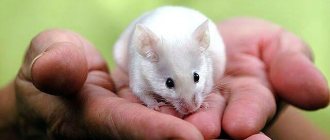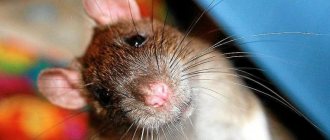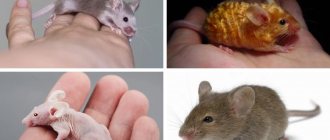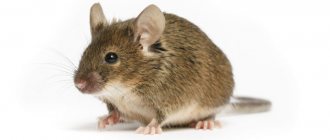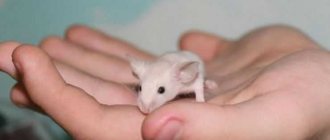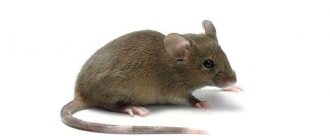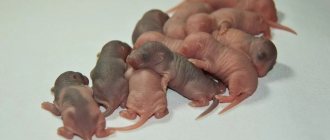The Japanese mouse is a tiny, funny animal native to Japan that is often kept as a pet. Moreover, some people are sure that they can pay attention only according to their mood. However, the Japanese mouse needs constant communication with its owner - tactile contact is extremely important for it.
Let's find out whether it is worth getting this dwarf rodent and how to properly care for it.
Description of the animal
Japanese mice are mammals that belong to the order of rodents. They live in parts of Southeast Asia. This species was first used as food for snakes. Then they found another use for the mice - various experiments were carried out with them in medical laboratories in Japan.
Appearance
The Japanese dwarf mouse is a tiny animal. Its body size is 4-6 cm in length, its weight rarely exceeds 6.5 g.
External features:
- elongated narrow muzzle;
- small eyes that look like dark beads;
- rather large semicircular ears;
- pink nose;
- vibrissae thin and long;
- the short neck smoothly transitions into an elongated body;
- miniature paws have 5 toes;
- the coat is short, soft to the touch;
- The color is white with gray or black spots, the lower part of the body is light.
Character and habits
The Japanese mouse is an active pet that is very interesting to watch. During the daytime, she usually sleeps in her house, and wakes up at dusk. At night she is constantly busy with something - running, sorting through her supplies, exploring every corner of the cage.
A Japanese mouse can jump in one place for hours, hang on the bars of a cage, or run in a wheel.
Attention! Due to disturbances in the functioning of the pituitary gland, the vestibular apparatus of the Japanese mouse is not well developed. For this reason, it moves in a zigzag or spins in place. For this feature the mouse is called dancing.
During the night she comes to the feeder countless times to eat.
Japanese mice are completely devoid of aggression. They enjoy spending time in human company. A pet can bite its owner only if it is very frightened or feels pain.
Health and life expectancy
In the wild, Japanese mice can live from several months to 1.5 years, because they have many natural enemies - birds, snakes and animals. The danger is not only from predators, but also from environmental conditions. Health is affected by air temperature and humidity. In addition, mice can become infected with infectious and parasitic diseases.
At home, the life expectancy of a pet increases to 2 years. After all, under human care he is safe, receives good nutrition and does not come into contact with wild animals.
Japanese mice have one disease that is inherited - inflammation of the inner ear. It appeared due to inbreeding in laboratory conditions.
Mouse's house - what is it like?
It's bad for a mouse to live alone . Therefore, let's assume that we don't have one pet, but at least a couple. Such small animals, of course, do not need a huge container. But it’s also not worth locking the little animals in a tiny carrier.
Mice love to dig . Therefore, there must be a sufficient layer of sawdust at the bottom of the container. I am often asked: “Why is a cage not suitable for Japanese mice?” There are several answers. And one of them is that it’s bad to put sawdust in it. Especially if you don't like them being outside the cage. Therefore, between a cage and a container (aquarium, etc.), we definitely choose a container.
Japanese women love to run . Give your pets the opportunity to run and climb. The container should have several levels with ladders, ropes, and pipes. So that the kids are interested and not bored. Branches brought from the street will also work. Just remember to wash them thoroughly.
The Japanese mouse is hyperactive . They need somewhere to put their energy. The wheel will save the mouse from boredom and allow it to splash out excess energy. Right now I have four wheels spinning behind me at once. I'm still thinking about how to attach a mobile phone charger to them)
Where to live? The house for mice can be absolutely anything. It’s better not to take wooden ones, even though they are very nice. The tree will absorb all the odors and will be a source of stench even when the cage is cleaned. A plastic house without a bottom will do (with a bottom will also work). What else could become a house for mice? Whatever! A jar of cottage cheese, a plastic cup, half a coconut.
Care and maintenance
Keeping a Japanese mouse is not burdensome. Caring for her is as simple as caring for a hamster. All the pet needs is a small cage with the necessary equipment, food, water and a little attention from the owner.
It is better to house several Japanese dwarf mice together. Two females can coexist peacefully in one cage. Males will not get along with each other - they will fight for territory. To start breeding Japanese mice, you can place together a pair of opposite-sex individuals or one male and two females.
Cage and filler
When choosing a home for Japanese mice, you should consider the number of pets that will use it. A small container with a lattice top is enough for one pair. The minimum size of the structure is 40x35 cm. The height can be any, but not less than 22 cm.
If the choice falls on a cage, you need to pay attention to the distance between the bars. It should not exceed 5 mm, otherwise the mice will run away. The tray must be made of plastic and have a height of at least 4 cm. Thanks to the high sides, the filler will not spill out.
Location
When choosing the location of the cage, you need to take into account that Japanese mice are sensitive to drafts. It should be placed in the back of the room, away from the window, so that when airing the pets do not catch a cold.
Direct sunlight should also not penetrate into the home of Japanese mice - overheating can lead to death. The bedroom is not the best place to install a terrarium. Pets are active at night, so they will disturb their owners’ sleep.
The optimal temperature for keeping Japanese mice is from 20 to 23 degrees. Suitable air humidity is 55-65%.
Home improvement
Filler is poured into the cage tray. Corn or wood will do, just not coniferous. This litter absorbs moisture well and absorbs unpleasant odors. Some people use office paper as filler. If there is no printing ink on it, this option is quite acceptable, but the paper underlay needs to be replaced more often.
Cage equipment for Japanese mice:
- Little house. It serves as a shelter. During the daytime, the pet rests there. You can make a nest with your own hands from an old flower pot, coconut shell, or buy a ready-made plastic house. Place some paper or filler inside.
- Drinking bowl. If there is enough space in the cage, you can place a small ceramic water container inside. Otherwise, a nipple drinker will do. It is fixed on the outside, and the tip with the ball is inserted into the cage. True, some pets never manage to learn how to use such a device.
- Feeder. You will need 2 small containers. In one they put a grain mixture for mice, in the other - wet food.
- Wheel. This is a treadmill for an active pet. Preference should be given to a solid structure rather than a lattice structure. If a mouse's tail gets caught in the hole while running, it could be seriously injured.
- Other inventory. These are stairs, tunnels - everything that will allow pets to actively spend time.
Attention! When setting up a cage, it is important to take care of the safety of Japanese mice. There should be no sharp corners inside. If the structure consists of several tiers, it is necessary to exclude the possibility of falling from a height.
Hygiene
Japanese mice are very clean. They spend most of their waking hours cleaning their fur. Despite this, if you do not clean the cage regularly, an unpleasant odor will appear. Therefore, once every 5-7 days it is necessary to restore order in the mice’s home.
To do this, pets are placed in another container. The cage is cleared of inventory. The dirty filler is thrown away and the tray is thoroughly washed with soda solution. The same is done with the wheel and tunnels. The feeder and drinker are scalded with boiling water. Clean bedding is placed at the bottom, the cage is set up, and then the mice are released.
Taming
To accustom a Japanese mouse to your hands, you need to pay attention to it every day. During the first days of your stay in the house, it is better not to touch it. Let her get used to new sounds and smells. Then the work of taming can begin. To do this, several times a day you should approach the container and talk to the mouse in a gentle voice. You can let him smell your fingers through the grill and offer him a treat - a seed or nut.
When the Japanese mouse gets used to it a little and begins to boldly take treats from your hands, you can try to pull it out of the cage, but not by force. You need to lower your palm inward and put a treat on it. The pet will have to sit on your hand to take what you want. If you do this every day, he will gradually get used to tactile contact.
The main thing when dealing with a Japanese mouse is to remember that its body is very fragile. It should not be grabbed or squeezed.
conclusions
The Japanese mouse is a funny and very interesting pet. Keeping and caring for animals is simple. However, if there are small children in the house, it is not recommended to buy a dwarf rodent - a child who wants to pet the mouse or catch it may accidentally harm it.
Rats What can and cannot be given to rats: a detailed table of goods Hello friends, in this table we tried to collect 65 64.2k.
Rats Make friends with a decorative pet mouse. Let's quickly and easily tame a small rodent in our arms. A mouse, like any animal, requires training. 10 21k.
Rodents Rodents are so different: which animal to choose for an apartment, a private house, for a child Traditionally, rodents are considered to be 0 20.8 thousand people.
Rats The rat is breathing heavily, grunting or choking. How can you help your beloved pet? Pets are often dangerous to our health. 8 19.4k.
Guinea pigs The best litter for a guinea pig: tips for choosing litter in a cage A guinea pig is like any other pet 0 17.6k.
Features of feeding
The diet of the Japanese mouse consists mainly of grains and vegetables. Pet stores sell various mixtures that include millet, corn, barley, oats and seeds. Some manufacturers add raisins and nuts to them. A miniature pet can eat about one teaspoon of food per day.
Among vegetables, the Japanese mouse prefers carrots, broccoli, zucchini and cucumbers. She will not refuse to eat fresh greens - dandelion leaves, plantain leaves or sprouted grains.
Attention! Prohibited foods include sweets, vegetables and fruits that cause fermentation, salty and fatty foods.
Japanese mice need protein, so 1-2 times a week they are offered a little boiled chicken breast or an egg. Sometimes you can pamper them with low-fat cottage cheese. Feeding homemade crackers is allowed, but not more than 1-2 times a month.
Japanese mice only drink water; it is better to use filtered water. It is important to ensure that the drinking bowl is always full. A mineral stone is placed or fixed near the feeder. Pets chew it when the body lacks calcium or other useful substances.
Rodent diet
Like any other mouse, the Japanese one eats:
All that should be remembered when feeding the animal is that it does not tolerate food from the human table. The Japanese mouse (photo can be seen on the page), like its relatives, cannot tolerate the smell of spices and excess salt in food.
As protein supplements, you can give animals low-fat cottage cheese, pieces of chicken fillet boiled without salt and spices, liver prepared in the same way, gammarus, shrimp, boiled egg white.
In order to provide the animals with drinking water, it is necessary to hang a drinking bowl on the wall of the cage.
The water needs to be changed at least once every 2-3 days.
It is necessary to periodically wash the inside of the drinker, otherwise blue-green algae will appear in it.
It is worth knowing that these animals are distinguished by exceptional mobility and jump quite high. If the animal is not yet accustomed to being handled, you can only pick it up by the tail. Hand training is carried out gradually; the owner will need a lot of patience and tasty treats, with the help of which he will develop positive associations with his hands in the animal.
Breeding
Puberty in Japanese mice occurs at one month of age. Pregnancy lasts 19-20 days. One litter can have 4-6 cubs. The mouse feeds them with milk for 3 weeks. After the end of the lactation period, the babies are sorted by gender and seated.
Methods for determining the sex of a Japanese mouse at the age of 10 days:
- females have nipples that are arranged in 2 rows;
- girls have a slightly larger distance between the anus and the urethra;
- Boys have dark spots in the lower abdomen - these are future testicles.
Attention! A pregnant Japanese mouse should not be disturbed - it can die from stress. After giving birth, it is not advisable to pick up the babies, otherwise the mother will eat them when she smells someone else's smell.
The Japanese mouse is an unpretentious and funny pet that can brighten up the life of a lonely elderly person or a large family with children. In the caring hands of his owner, he will be able to live a full life.
Catch a Japanese mouse
An incident from our life, I think some may find it useful.
One day I had to face the need to catch kids who had escaped through the cracks. The task, I must say, is not the easiest. You wouldn't put a mousetrap on your pets, would you? Moreover, on such small ones. But patience and attentiveness, as well as the participation of the whole family in the event, led to the successful completion of the capture campaign.
The funniest thing was that the last two fugitives were caught. One decided that the vacuum cleaner pipe was the best mink. Where he was caught. The second one was unlucky. He was climbing somewhere up and fell into a bucket. Luckily, the bucket is empty. And there were even a few grains in it that the parrots had shaken into it. So he wasn't even very hungry. The rest were caught as usual. Noticing where the mouse had run, they blocked all the cracks and possible escape routes with boards, leaving only one path. While they are small, they are not very smart. The main thing is to notice where they are running.
The main question you will ask before buying an animal is how long does a Japanese mouse live ? If you follow all the rules of care, maintenance and feeding described above, then the baby can live for about two years. A mouse's lifespan is short, keep that in mind.
Colors of decorative mice
Breeders have developed interesting varieties of mice, differing in the type of coat (standard, long-haired, satin, curly) and a wide variety of colors.
Solid colors - animals are painted in one color - white, black, blue, red, silver, etc. Source: decorative mice
The colors are “tan” (red tan on the main background) and “fox” (white tan).
The marked colors take into account the location of spots and color zones. These are tape, Dutch, broken marked, etc.
Variegated - colored specks are located on a main white background.
There are many more options, in particular the wild color agouti, sable, chinchilla, Siamese and many others. You can find short-tailed and naked mice, so anyone who decides to have this curious animal at home will definitely find a pet to suit their taste.

